With a crimping tool, strip away a portion of the sheath, untangle and arrange the wires in the correct order, fit them into the connector, and use the crimping part of your tool to squeeze the small pins into the wires and secure the connector. If you don't have a crimping tool, no problem! Use a pair of scissors or a utility knife to cut away a section of the sheathing at the end of the cable, untwist and arrange the small cables in the right order, put them into the RJ-45 connector, and use a small, flathead screwdriver to press down each of the pins.
Step 1
Strip the cable back 1 inch (25 mm) from the end. Insert the cable into the stripper section of the tool and squeeze it tight. Then, rotate the crimping tool around the cable in a smooth and even motion to create a clean cut.
Keep the tool clamped and pull away towards the end of the wire to remove the sheathing.
The stripping section is a round hole near the handle of the tool. The sheathing should come off cleanly, leaving the wires exposed.
Step 2
Untwist and straighten the wires inside of the cable. Inside of the cable you'll see a bunch of smaller wires twisted together. Separate the twisted wires and straighten them out so they're easier to sort into the right order.
Cut off the small plastic wire separator or core so it's out of the way. Don't cut off or remove any of the wires or you won't be able to crimp them into the connector.
Step 3
Arrange the wires into the right order. Use your fingers to put the wires in the correct order so they can be properly crimped. The proper sequence is as follows from left to right: Orange/White, Orange, Green/White, Blue, Blue/White, Green, Brown/White, Brown.
There are 8 wires in total that need to be arranged in the right sequence. Note that the wires labeled Orange/White or Brown/White indicate the small wires that have 2 colors.
Step 4
Cut the wires into an even line 1/2 inch (13 mm) from sheathing. Hold the wires with your thumb and index finger to keep them in order. Then, use the cutting section of the crimping tool to cut them into an even line.
The cutting section of the tool will resemble wire cutters. The wires must be in an even line to be crimped into the RJ-45 connector properly. If you cut them in an uneven line, move further down the wires and cut them again.
Tip: If your tool doesn't have a cutting section, use a pair of wire cutters or scissors to cut the small wires.
Step 5
Insert the wires into the RJ-45 connector. Hold the RJ-45 connector so the clip is on the underside and the small metal pins are facing up. Insert the cable into the connector so that each of the small wires fits into the small grooves in the connector.
The sheathing of the cable should fit just inside of the connector so it's past the base. If any of the small wires bend or don't fit into a groove correctly, take the cable out and straighten the wires with your fingers before trying again.
The wires must be inserted in the correct order and each wire must fit into a groove before you crimp the connector.
Step 6
Stick the connector into the crimping part of the tool and squeeze twice. Insert the connector in the crimping section of the tool until it can't fit any further. Squeeze the handles to crimp the connector and secure the wires. Release the handles, then squeeze the tool again to make sure all of the pins are pushed down.
The crimping tool pushes small pins in the grooves down onto the wires to hold and connect them to the RJ-45 connector.
Step 7
Remove the cable from the tool and check that all of the pins are down. Take the connector out of the tool and look at the pins to see that they're all pushed down in an even line. Lightly tug at the connector to make sure it's attached to the cable.
If any of the pins aren't pushed down, put the wire back into the crimping tool and crimp it again.
Article source: wikiHow wikiHow is a group effort to create a great resource: the world's largest free how to manual. wikiHow articles help people solve their everyday problems. wikiHow licenses all content under a Creative Commons License. The license allows wikiHow content to be used freely for noncommercial purposes. The Creative Commons License also allows for the creation of derivative works.
More Network Troubleshooting and Support Articles:
• Network Schematic Symbols
• Network Topology Diagram
• The Secret of Maintaining Your Fiber Optic Network
• The Difference Between EoP and PoE
• Troubleshooting the Intermediate System to Intermediate System (IS-IS) Protocol
• Letting Your SME Users Access the Internet
• Structured Cabling - A Detailed Tutorial and Even More!
• How to Choose Work Area Network Cable Faceplate Locations
• Built-in Utilities for Network Troubleshooting
• Structured Network Troubleshooting Methodology


